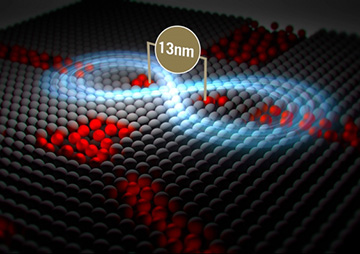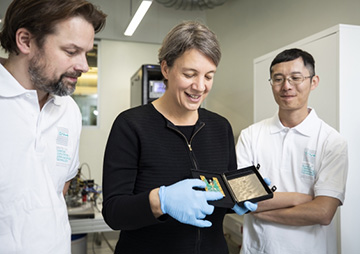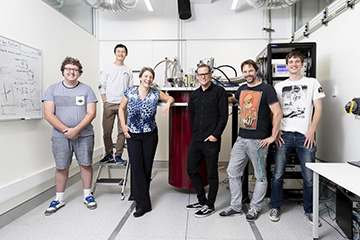The research team behind the UNSW work on atom-based qubits in silicon included (left to right) co-lead-authors Sam Gorman and Yu He, team leader Michelle Simmons, Ludwik Kranz, Joris Keizer and Daniel Keith. [Image: UNSW Sydney] [Enlarge image]
In a tour-de-force of atom-scale engineering, a research team at the University of New South Wales (UNSW), Australia, has demonstrated a two-qubit gate between coupled donor atom qubits in silicon—the first time, according to the researchers, that such a feat has been accomplished (Nature, doi: 10.1038/s41586-019-1381-2). The work potentially overcomes one significant hurdle in building quantum computers with atom-based qubits on a silicon platform.
Bringing atom qubits to silicon
Atom- and ion-based qubits have some notable attractions as candidates for quantum computing. A particular plus is these systems’ long coherence times, the ability to hang onto delicate quantum information for more than instant. This and other advantages have made assemblages of ions or atoms trapped in lattices of laser beams a key locus of advances in quantum research, with some standout recent accomplishments, for example, in quantum simulation.
Technologists and engineers would like to bring some of those same advantages of atom-based qubits to silicon. In principle, that would mean that efforts to build quantum computers could leverage the infrastructure and techniques honed over decades in fashioning semiconductors for classical computers.
Moreover, as Michelle Simmons, the leader of the UNSW team, noted in a press release accompanying the research, electron-spin qubits donated by single atoms “hold the world record” for qubits in silicon under several metrics. Previous work has shown, for example, that such qubits in silicon can have coherence times in the seconds, with potential gate fidelities (and, hence, coherent control) on the order of 99.9%.
The big problem has been getting these atoms close enough together to “talk” to one another in a quantum-mechanical sense—through phenomena such as entanglement—and thus form quantum-computational logic gates, while still maintaining the ability to control and measure each atom qubit individually. As a result, while a number of research teams have demonstrated two-qubit gates in silicon using qubits bigger than individual atoms, such as quantum dots, the same feat hadn’t yet been achieved for individual-atoms-based qubits until the recent work by the UNSW team.
STM hydrogen lithography
To create such a two-qubit gate between atom-based qubits, Simmons and her team used a technique, scanning tunneling microscope (STM) hydrogen lithography, that the research group has been honing for some 20 years.
The method begins with a natural silicon substrate—the surface of which, through a number of high-temperature chemical steps, the researchers then coat with a layer of monoatomic hydrogen. Next, the tip of an STM is used to individually pick off hydrogen atoms from that surface, creating an atom-scale lithographic mask on the surface, with nanometer precision. Finally, the surface is exposed to a phosphorous–hydrogen gas at 350 °C, leaving behind phosphorous in the exposed areas.

The UNSW team’s STM hydrogen lithography technique allowed it to construct a two-qubit logic gate consisting of phosphorous atoms placed a mere 13 nm apart, along with associated circuitry. [Image: UNSW Sydney Media Office]
Qubits, transistor and leads
By applying this method, the team was able to deposit phosphorous atom qubits—a left qubit consisting of two phosphorous atoms, and a right qubit including three—separated by a mere 13 nm. (The left–right asymmetry between the number of donor atoms was engineered intentionally, according to the paper, in part to increase the tunability of the exchange interaction between the qubits.)
The researchers also used the technique to lay down associated circuitry for a quantum gate between the two qubits. That circuitry included source and drain leads, as well as a nearby single-electron transistor that serves, through weak tunnel-coupling with the qubits, as an electron reservoir and charge sensor.
The team then popped the fabricated device into 50-mK dilution refrigerator, and tested its ability to implement a particular quantum logic gate—a so-called (SWAP)½ gate—on a variety of electron spin basis states from the donor atoms. The team was able to read out the gate results with 94% fidelity.
“We were able to bring the qubit’s electrons closer or further apart, effectively turning on and off the interaction between them, a prerequisite for a quantum gate,” Yu He, one of the paper’s two lead co-authors (along with Sam Gorman), said in a press release. And the gate operation was blazingly fast, with the two-qubit SWAP exchange happening in a mere 800 ps.

Joris Keizer, Michelle Simmons and Yu He in the lab. [Image: UNSW Sydney Media Office]
Exquisite engineering
In an email to OPN, Simmons noted that one of the key points of the paper was the exquisite engineering that the technique allows. “We engineer the atoms to be [around] 13nm apart, to create entanglement,” she said, “but at the same time have the control to independently measure one qubit with high fidelity, without altering the neighboring qubit despite their close proximity.”
Simmons added that the fact that the platform uses only phosphorous and silicon atoms allows (as the team had shown in previous work) “very low noise quantum circuitry.” That’s because the system “[gets] rid of any dielectrics of different materials, which typically cause charge noise and/or irregularities at the interfaces found in semiconductor quantum dots.”
In the paper, the team noted that in the long run, the hope is that, by leveraging these techniques, the group can “utilize the hallmark long coherence times that are normally associated with ion trap qubits together with the scalability of the silicon material system to realize a large-scale quantum processor.” Simmons told OPN that she and her colleagues are “excited about the possibilities,” but also noted that the work is still at an early stage. “Watch this space,” she said.

